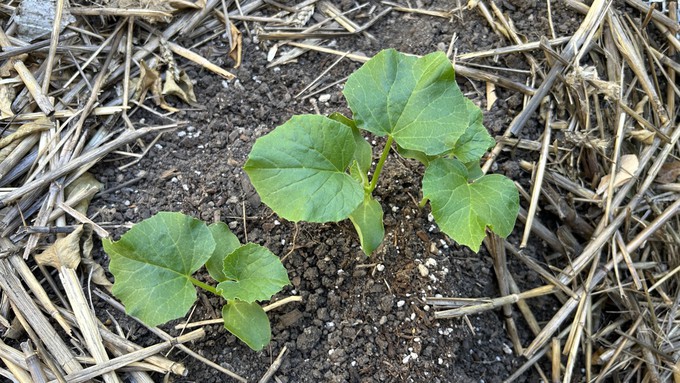
Warm weather brings rapid snow melt – and cold water

The warm May weather means melon plants (these are Ambrosias), as well as squash, pumpkins and cucumbers, pop up quickly from seed. Keep seedlings watered and mulched as they mature. Kathy Morrison
Typical for May, Sacramento can expect more warm days this week, says the National Weather Service. What’s not so typical is the Sierra snow pack, which is melting rapidly. Higher-than-normal temperatures accompanied by thunderstorms are turning those snow caps into runoff, filling local rivers and streams with very icy water.
Although it may be tempting to plunge into the American or Sacramento rivers, watch out!
“It's going to be another warm weekend, with above-average temps throughout much of the valley and foothills, with a 15-30% chance of isolated thunderstorms in the mountains,” tweeted the NWS Sacramento office. “Remember that though the air is HOT, the water is COLD. Think twice before getting in!”
That cold water is good news for farmers and gardeners. It looks like we’ll have ample supplies for this summer’s crops.
As for those temperatures, forecast highs for Sacramento top out at 94 degrees Monday, says the weather service. Normal for this week: 80 degrees. Lows are on the high side, too, with 58 degrees forecast for Monday and Tuesday.
Breezy conditions later this week will bring some relief; forecast highs for Wednesday through Friday are 77 to 79 degrees.
Make the most of this warm spring weather. If you haven’t already, plant your summer vegetables.
* Time to set out those tomato transplants along with peppers and eggplants. Pinch off any flowers on new transplants to make them concentrate on establishing roots instead of setting premature fruit.
* Direct-seed melons, cucumbers, summer squash, corn, radishes, pumpkins and annual herbs such as basil.
* Harvest cabbage, lettuce, peas and green onions.
* In the flower garden, direct-seed sunflowers, cosmos, salvia, zinnias, marigolds, celosia and asters. For faster flowers, transplant seedlings for many of the same plants.
* Plant dahlia tubers. Other perennials to set out include verbena, coreopsis, coneflower and astilbe.
* Transplant petunias, marigolds and perennial flowers such as astilbe, columbine, coneflowers, coreopsis, dahlias, rudbeckia and verbena.
* Keep an eye out for slugs, snails, earwigs and aphids that want to dine on tender new growth.
* Feed summer bloomers with a balanced fertilizer.
* For continued bloom, cut off spent flowers on roses as well as other flowering plants.
* Don’t forget to water. Seedlings need moisture. Deep watering will help build strong roots and healthy plants.
* Put your veggie garden on a regular diet. Set up a monthly feeding program, and keep track on your calendar. Make sure to water your garden before applying any fertilizer to prevent “burning” your plants.
Comments
0 comments have been posted.Sacramento Digs Gardening to your inbox.
Sites We Like
Garden Checklist for week of April 14
It's still not warm enough to transplant tomatoes directly in the ground, but we’re getting there.
* April is the last chance to plant citrus trees such as dwarf orange, lemon and kumquat. These trees also look good in landscaping and provide fresh fruit in winter.
* Smell orange blossoms? Feed citrus trees with a low dose of balanced fertilizer (such as 10-10-10) during bloom to help set fruit. Keep an eye out for ants.
* Apply slow-release fertilizer to the lawn.
* Thoroughly clean debris from the bottom of outdoor ponds or fountains.
* Spring brings a flush of rapid growth, and that means your garden needs nutrients. Fertilize shrubs and trees with a slow-release fertilizer. Or mulch with a 1-inch layer of compost.
* Azaleas and camellias looking a little yellow? If leaves are turning yellow between the veins, give them a boost with chelated iron.
* Trim dead flowers but not leaves from spring-flowering bulbs such as daffodils and tulips. Those leaves gather energy to create next year's flowers. Also, give the bulbs a fertilizer boost after bloom.
* Pinch chrysanthemums back to 12 inches for fall flowers. Cut old stems to the ground.
* Mulch around plants to conserve moisture and control weeds.
* From seed, plant beans, beets, cantaloupes, carrots, corn, cucumbers, melons, radishes and squash.
* Plant onion sets.
* In the flower garden, plant seeds for asters, cosmos, celosia, marigolds, salvia, sunflowers and zinnias.
* Transplant petunias, zinnias, geraniums and other summer bloomers.
* Plant perennials and dahlia tubers for summer bloom.
* Mid to late April is about the last chance to plant summer bulbs, such as gladiolus and tuberous begonias.
* Transplant lettuce seedlings. Choose varieties that mature quickly such as loose leaf.